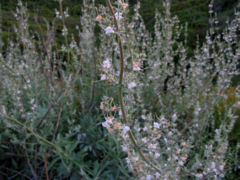White sage: Difference between revisions
No edit summary |
No edit summary |
||
| Line 1: | Line 1: | ||
{{SPlantbox | |||
|familia=Lamiaceae | |||
|genus=Salvia | |||
|species=apiana | |||
|common_name=Bee sage, California white sage, White sage | |||
|name_ref=Flora - A Gardener's Encyclopedia | |||
|habit=shrub | |||
|habit_ref=Flora - A Gardener's Encyclopedia | |||
|Max ht box=4 | |||
|Max ht metric=ft | |||
|height_ref=Flora - A Gardener's Encyclopedia | |||
|Max wd box=3 | |||
|Max wd metric=ft | |||
|width_ref=Flora - A Gardener's Encyclopedia | |||
|lifespan=perennial | |||
|life_ref=Flora - A Gardener's Encyclopedia | |||
|exposure=sun | |||
|sun_ref=Flora - A Gardener's Encyclopedia | |||
|features=flowers | |||
|flower_season=early spring, mid spring, late spring | |||
|flower_ref=Flora - A Gardener's Encyclopedia | |||
|flowers=blue, purple, white | |||
|Temp Metric=°F | |||
|min_zone=9 | |||
|usda_ref=Flora - A Gardener's Encyclopedia | |||
|max_zone=11 | |||
|image=Upload.png | |||
|image_width=240 | |||
}} | |||
{{Taxobox | {{Taxobox | ||
| color = lightgreen | | color = lightgreen | ||
Revision as of 12:06, 7 May 2010
| Salvia apiana subsp. var. | Bee sage, California white sage, White sage | |||||||||||||||||||||||||||||||||||||||||||||||||||||||
|---|---|---|---|---|---|---|---|---|---|---|---|---|---|---|---|---|---|---|---|---|---|---|---|---|---|---|---|---|---|---|---|---|---|---|---|---|---|---|---|---|---|---|---|---|---|---|---|---|---|---|---|---|---|---|---|---|

|
|
| ||||||||||||||||||||||||||||||||||||||||||||||||||||||
| ||||||||||||||||||||||||||||||||||||||||||||||||||||||||
| White sage {{{status}}} Fossil range: {{{fossil_range}}}
| ||||||||||||||||||||||||||||||||||||||||||||||||||||||||||||||||||
|---|---|---|---|---|---|---|---|---|---|---|---|---|---|---|---|---|---|---|---|---|---|---|---|---|---|---|---|---|---|---|---|---|---|---|---|---|---|---|---|---|---|---|---|---|---|---|---|---|---|---|---|---|---|---|---|---|---|---|---|---|---|---|---|---|---|---|
 | ||||||||||||||||||||||||||||||||||||||||||||||||||||||||||||||||||
| Plant Info | ||||||||||||||||||||||||||||||||||||||||||||||||||||||||||||||||||
| ||||||||||||||||||||||||||||||||||||||||||||||||||||||||||||||||||
| Scientific classification | ||||||||||||||||||||||||||||||||||||||||||||||||||||||||||||||||||
| ||||||||||||||||||||||||||||||||||||||||||||||||||||||||||||||||||
| [[{{{diversity_link}}}|Diversity]] | ||||||||||||||||||||||||||||||||||||||||||||||||||||||||||||||||||
| {{{diversity}}} | ||||||||||||||||||||||||||||||||||||||||||||||||||||||||||||||||||
| Binomial name | ||||||||||||||||||||||||||||||||||||||||||||||||||||||||||||||||||
| Salvia apiana Jepson | ||||||||||||||||||||||||||||||||||||||||||||||||||||||||||||||||||
| Trinomial name | ||||||||||||||||||||||||||||||||||||||||||||||||||||||||||||||||||
| {{{trinomial}}} | ||||||||||||||||||||||||||||||||||||||||||||||||||||||||||||||||||
| Type Species | ||||||||||||||||||||||||||||||||||||||||||||||||||||||||||||||||||
| {{{type_species}}} | ||||||||||||||||||||||||||||||||||||||||||||||||||||||||||||||||||
| {{{subdivision_ranks}}} | ||||||||||||||||||||||||||||||||||||||||||||||||||||||||||||||||||
| [[Image:{{{range_map}}}|{{{range_map_width}}}|]] | ||||||||||||||||||||||||||||||||||||||||||||||||||||||||||||||||||
| Synonyms | ||||||||||||||||||||||||||||||||||||||||||||||||||||||||||||||||||
| {{{synonyms}}} |
White sage (Salvia apiana), also known as Sacred sage, is an evergreen perennial shrub of the genus Salvia, the sages. It is native to the southwestern United States and northwestern Mexico, being found mainly in the coastal sage scrub habitat of Southern California and Baja California, on the western edges of the Mojave and Sonoran deserts.
Morphology
White sage is a sub-shrub that is less than 1 m tall. The leaves are widely lanceolate and tapered at the base. The margin is minutely toothed and rounded. The leaves are generally basal, covered with dense hairs, which gives it a white coloring, and are about 4–8 cm long. The inflorescence is a spike-like clusters with few flowers. The flowers are bilateral, about 12–22 mm in length, and are white with lavender spots and streaks. Both the stamens and styles are exserted. The fruit form into shiny, light brown nutlets that are 2.5–3 mm in size.
Ecology and Reproduction
White sage is a common plant that requires well drained dry soil, full sun, and little water. They occur on dry slopes in coastal sage scrub, chaparral, and yellow-pine forests of Southern California to Baja California at less than 1500 m elevation.
Bumblebees, hawk moths and wasps pollinate the White sage, and hummingbirds also appear to like the plant.
The white sage typically flowers between May and August.
Ethnobotany
Native Americans had several uses for this plant: seeds were ground into a flour and used for mush; leaves were used for flavoring in cooking; leaves were also eaten, smoked or used in a sweathouse as a remedy for colds; seeds were dropped into the eye and permitted to roll around under the eyelids in order to cleanse the eyes; and leaves were crushed and mixed with water to create a hair shampoo, dye and straightener.
White sage is also used medicinally. It can be made into a tea, which decreases sweating, salivation, and mucous secretions in the sinuses, throat, and lungs. Cold tea can be a good stomach tonic, while a lukewarm tea is good for treating sore throats. The leaves can also be used as a uterine hemostatic tea for heavy menstruation; however, since it can also decrease lactation, nursing mothers are advised not to use it.
White sage is considered sacred by many Native Americans since it is used to make smudge sticks, a type of incense. White sage is believed to cleanse a space of any evil spirits that may be present. This power is said to be released from the plant by the burning of the leaves, which are typically bundled into a wand or stick. Today many Native American tribes still use the stems and leaves for smudging as part of purification ceremonies.